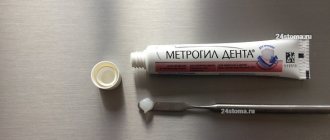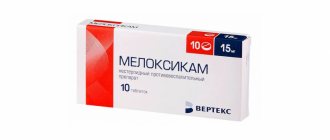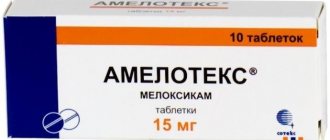Ifimol 10 mg/ml 100 ml solution for infusion Unique Pharmaceutical Laboratories
pharmachologic effect
Analgesic-antipyretic. It has analgesic, antipyretic and weak anti-inflammatory effects. The mechanism of action is associated with inhibition of prostaglandin synthesis, with a predominant effect on the thermoregulation center in the hypothalamus.
Composition and release form Ifimol 10 mg/ml 100 ml solution for infusion Unique Pharmaceutical Laboratories
Solution - 1 ml:
- Active substance: paracetamol 10 mg.
- Excipients: propylene glycol - 8 mg, citric acid monohydrate - 0.47 mg, sodium disulfite - 0.5 mg, sodium hydrogen phosphate dihydrate - 0.89 mg, sodium chloride - 2 mg, water for injection - qs up to 1 ml.
100 ml - glass bottles (1) - cardboard packs.
Description of the dosage form
Solution for infusion; transparent, colorless to light yellow.
Directions for use and doses
Orally or rectally in adults and adolescents weighing more than 60 kg, use a single dose of 500 mg, frequency of administration - up to 4 times a day. The maximum duration of treatment is 5-7 days.
Maximum doses: single - 1 g, daily - 4 g.
Single oral doses for children aged 6-12 years - 250-500 mg, 1-5 years - 120-250 mg, from 3 months to 1 year - 60-120 mg, up to 3 months - 10 mg/kg. Single doses for rectal use in children aged 6-12 years - 250-500 mg, 1-5 years - 125-250 mg.
Frequency of use - 4 times a day with an interval of at least 4 hours. Maximum duration of treatment - 3 days.
Maximum dose: ;4 single doses per day.
Pharmacokinetics
After oral administration, paracetamol is rapidly absorbed from the gastrointestinal tract, mainly in the small intestine, mainly by passive transport. After a single dose of 500 mg, Cmax in blood plasma is reached after 10-60 minutes and is about 6 μg/ml, then gradually decreases and after 6 hours it is 11-12 μg/ml.
Widely distributed in tissues and mainly in body fluids, with the exception of adipose tissue and cerebrospinal fluid.
Protein binding is less than 10% and increases slightly with overdose. Sulfate and glucuronide metabolites do not bind to plasma proteins even at relatively high concentrations.
Paracetamol is metabolized primarily in the liver by conjugation with glucuronide, conjugation with sulfate and oxidation with the participation of mixed liver oxidases and cytochrome P450.
The negatively active hydroxylated metabolite N-acetyl-p-benzoquinoneimine, which is formed in very small quantities in the liver and kidneys by mixed oxidases and is usually detoxified by binding to glutathione, can escalate with paracetamol overdose and cause tissue damage.
In adults, most paracetamol is bound to glucuronic acid and, to a lesser extent, to sulfuric acid. These conjugated metabolites do not have biological activity. In premature infants, newborns and in the first year of life, the sulfate metabolite predominates.
T1/2; is 1-3 hours. In patients with liver cirrhosis, T1/2; is slightly longer. The renal clearance of paracetamol is 5%.
It is excreted in the urine mainly in the form of glucuronide and sulfate conjugates. Less than 5% is excreted as unchanged paracetamol.
Indications for use Ifimol 10 mg/ml 100 ml solution for infusion Unique Pharmaceutical Laboratories
Pain syndrome of weak and moderate intensity of various origins (including headache, migraine, toothache, neuralgia, myalgia, algodismenorrhea; pain from injuries, burns). Fever in infectious and inflammatory diseases.
Contraindications
Chronic alcoholism, hypersensitivity to paracetamol.
Application of Ifimol 10 mg/ml 100 ml solution for infusion by Unique Pharmaceutical Laboratories during pregnancy and lactation
Paracetamol penetrates the placental barrier. To date, there have been no negative effects of paracetamol on the fetus in humans.
Paracetamol is excreted in breast milk: the content in milk is 0.04-0.23% of the dose taken by the mother.
If it is necessary to use paracetamol during pregnancy and lactation (breastfeeding), you should carefully weigh the expected benefits of therapy for the mother and the potential risk to the fetus or child.
Experimental studies have not established the embryotoxic, teratogenic and mutagenic effects of paracetamol.
Use in children
Application is possible according to the dosage regimen.
special instructions
Use with caution in patients with impaired liver and kidney function, with benign hyperbilirubinemia, as well as in elderly patients.
With long-term use of paracetamol, monitoring of the peripheral blood picture and the functional state of the liver is necessary.
Side effects Ifimol 10 mg/ml 100 ml solution for infusion Unique Pharmaceutical Laboratories
From the digestive system: rarely - dyspeptic symptoms, with long-term use in high doses - hepatotoxic effect.
From the hematopoietic system: rarely - thrombocytopenia, leukopenia, pancytopenia, neutropenia, agranulocytosis.
Allergic reactions: rarely - skin rash, itching, urticaria.
Drug interactions
When used simultaneously with inducers of microsomal liver enzymes and drugs with hepatotoxic effects, there is a risk of increasing the hepatotoxic effect of paracetamol.
When used simultaneously with anticoagulants, a slight or moderate increase in prothrombin time is possible.
When used simultaneously with anticholinergic drugs, the absorption of paracetamol may be reduced.
When used simultaneously with oral contraceptives, the elimination of paracetamol from the body is accelerated and its analgesic effect may be reduced.
When used simultaneously with uricosuric drugs, their effectiveness decreases.
With simultaneous use of activated carbon, the bioavailability of paracetamol decreases.
When used simultaneously with diazepam, the excretion of diazepam may be reduced.
There are reports of the possibility of enhancing the myelosuppressive effect of zidovudine when used simultaneously with paracetamol. A case of severe toxic liver damage has been described.
Cases of toxic effects of paracetamol have been described when used simultaneously with isoniazid.
When used simultaneously with carbamazepine, phenytoin, phenobarbital, primidone, the effectiveness of paracetamol decreases, which is due to an increase in its metabolism (glucuronidation and oxidation processes) and excretion from the body. Cases of hepatotoxicity have been described with the simultaneous use of paracetamol and phenobarbital.
When using cholestyramine for a period of less than 1 hour after taking paracetamol, the absorption of the latter may be reduced.
When used simultaneously with lamotrigine, the excretion of lamotrigine from the body moderately increases.
When used simultaneously with metoclopramide, it is possible to increase the absorption of paracetamol and increase its concentration in the blood plasma.
When used simultaneously with probenecid, the clearance of paracetamol may be reduced; with rifampicin, sulfinpyrazone - it is possible to increase the clearance of paracetamol due to an increase in its metabolism in the liver.
When used simultaneously with ethinyl estradiol, the absorption of paracetamol from the intestine increases.
Ifimol®
Intravenous single infusion over 15 minutes.
The drug should not be mixed in the same infusion bottle with other medications.
The infusion should be carried out immediately after opening the bottle; the unused remainder of the drug is destroyed. Before starting the infusion, the bottle with the drug should be carefully inspected for the absence of visible mechanical particles and changes in the color of the solution.
Additional dilution with 0.9% sodium chloride solution is allowed, by an additional 1/10 of the original volume. This diluted solution should be used within 1 hour of its preparation (including the infusion time).
For infusion, a needle with a diameter of 0.8 mm is used, which is inserted into the bottle while holding the bottle strictly vertically.
As with other infusion solutions, extreme care should be taken to avoid air bubble embolism, especially at the end of the infusion, regardless of the vein into which the drug is injected.
Unintentionally exceeding recommended doses may result in serious impairment of liver function, including death. When determining the dose, the individual risk factors for hepatotoxicity present in the patient should also be taken into account: liver failure, chronic alcoholism, chronic malnutrition, dehydration.
Doses are calculated based on the patient's body weight.
Body weight ≤
10 kg
**:
7.5 mg/kg paracetamol per infusion, i.e. 0.75 ml/kg, up to 4 times a day.
The minimum interval between administrations should be at least 4 hours.
The maximum daily dose of paracetamol should not exceed 30 mg/kg*.
Body weight from 10 to 33 kg
:
15 mg/kg paracetamol per infusion, i.e. 1.5 ml/kg, up to 4 times a day.
The minimum interval between administrations should be at least 4 hours.
The maximum daily dose of paracetamol should not exceed 60 mg/kg, but not more than 2 g*.
Body weight from 33 to 50 kg:
15 mg/kg paracetamol per infusion, i.e. 1.5 ml/kg. The minimum interval between administrations should be at least 4 hours.
The maximum daily dose of paracetamol should not exceed 60 mg/kg, but not more than 3 g*.
Body weight over 50 kg:
the maximum single dose is 1 g of paracetamol, i.e. 1 bottle (100 ml), up to 4 times a day. The minimum interval between administrations should be 4 hours.
The maximum daily dose is 4 g*.
* Maximum daily dose taking into account all medications containing paracetamol or propacetamol.
**The safety and effectiveness of the drug for premature infants has not been established.
When administering the drug to children and adolescents, the bottle with the drug cannot be suspended as an infusion vessel due to the small volume of the drug administered.
To avoid errors when calculating doses for children weighing less than 10 kg, it is recommended to indicate the volume for a single administration in milliliters, while in this group of patients the administered volume of the drug Ifimol®, solution for infusion 10 mg/ml should not exceed 7.5 ml per one infusion.
In patients with lower body weight, administration of smaller volumes of the drug is required.
In order to measure the dose of the drug, taking into account the child’s body weight and the required volume, 5 ml or 10 ml syringes should be used.
The volume of the drug required for administration to the patient must be removed from the bottle and diluted in a 0.9% sodium chloride solution in a ratio of 1:10 (one volume of the drug in nine volumes of the dilution solution) and administered to the patient within 15 minutes.
For severe renal impairment
(creatinine clearance <30 ml/min) the interval between drug administrations should be at least 6 hours.
In patients with impaired liver function
The daily dose of paracetamol should be reduced or the interval between doses of the drug should be increased.
The maximum daily dose of paracetamol should not exceed 60 mg/kg (not more than 2 g/day) in the following cases:
- in adults weighing less than 50 kg;
- for chronic liver diseases or compensated liver diseases in the active stage in adults, especially with mild or moderate liver failure;
- Gilbert's syndrome (familial hyperbilirubinemia);
-in patients with chronic alcoholism;
- in case of nutritional disorders (low glutathione reserves);
-in patients with dehydration.
No dose adjustment is required for elderly patients.
Ifimol
From the skin: itching, rash on the skin and mucous membranes (usually erythematous, urticaria), angioedema, exudative erythema multiforme (including Stevens-Johnson syndrome), toxic epidermal necrolysis (Lyell's syndrome).
From the side of the central nervous system (usually develops when taking high doses): dizziness, psychomotor agitation and disorientation.
From the digestive system: nausea, epigastric pain, increased activity of liver enzymes, usually without the development of jaundice, hepatonecrosis (dose-dependent effect).
From the endocrine system: hypoglycemia, up to hypoglycemic coma.
From the hematopoietic organs: anemia, sulfhemoglobinemia and methemoglobinemia (cyanosis, shortness of breath, heart pain), hemolytic anemia (especially for patients with glucose-6-phosphate dehydrogenase deficiency). With long-term use in large doses - aplastic anemia, pancytopenia, agranulocytosis, neutropenia, leukopenia, thrombocytopenia.
From the urinary system: (when taking large doses) - nephrotoxicity (renal colic, interstitial nephritis, papillary necrosis). Overdose. Symptoms (acute overdose develops 6-14 hours after taking paracetamol, chronic - 2-4 days after exceeding the dose) of acute overdose: dysfunction of the gastrointestinal tract (diarrhea, loss of appetite, nausea and vomiting, abdominal discomfort and/or pain in stomach), increased sweating.
Symptoms of chronic overdose: a hepatotoxic effect develops, characterized by general symptoms (pain, weakness, adynamia, increased sweating) and specific ones characterizing liver damage. As a result, hepatonecrosis may develop. The hepatotoxic effect of paracetamol may be complicated by the development of hepatic encephalopathy (thought disturbances, central nervous system depression, stupor), convulsions, respiratory depression, coma, cerebral edema, hypocoagulation, development of disseminated intravascular coagulation syndrome, hypoglycemia, metabolic acidosis, arrhythmia, collapse. Rarely, liver dysfunction develops suddenly and can be complicated by renal failure (renal tubular necrosis).
Treatment: administration of SH-group donors and precursors for the synthesis of glutathione - methionine 8-9 hours after an overdose and N-acetylcysteine - after 12 hours. The need for additional therapeutic measures (further administration of methionine, intravenous administration of N-acetylcysteine) is determined in depending on the concentration of paracetamol in the blood, as well as on the time elapsed after its administration.


